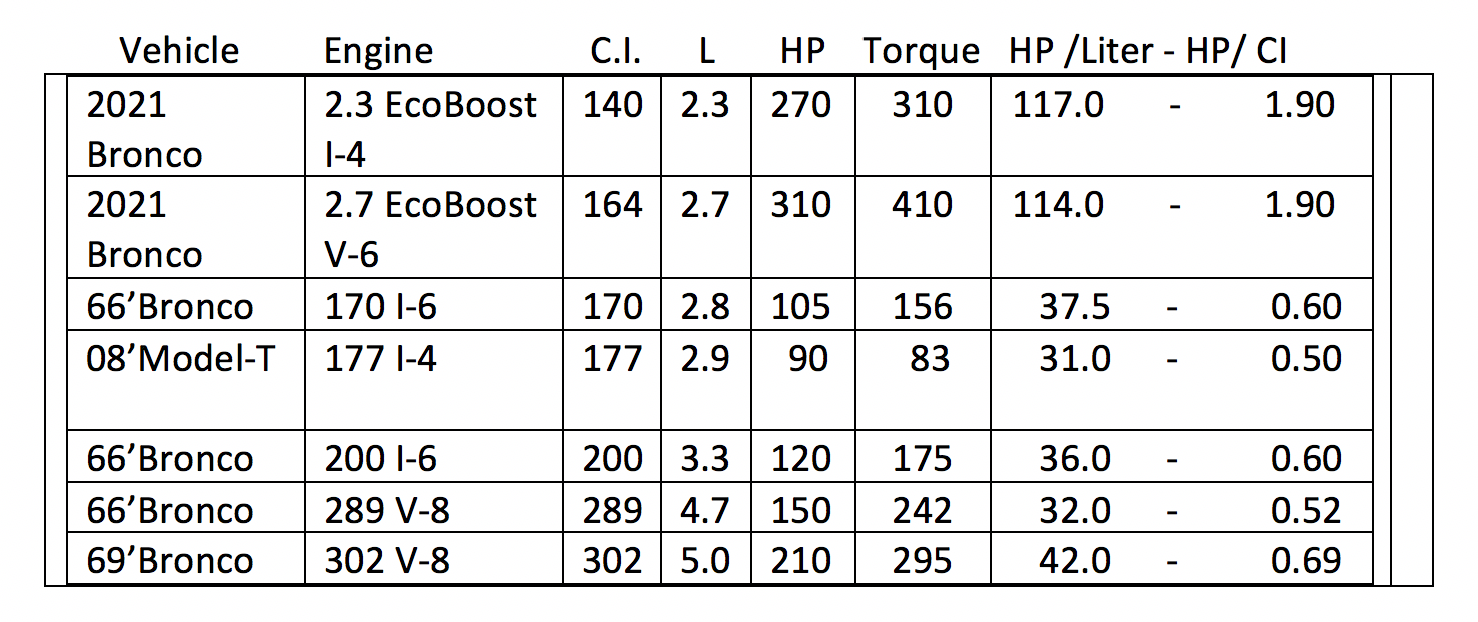By Bob Burns:
Efficiency is doing better what is already being done.
The saying goes, “There’s no replacement for displacement.” Well, maybe there is.
Displacement refers to the size of an engine calculated on the volume that an engine would “displace” if each cylinder were filled with a liquid or a gas, such as air. The internal combustion (IC) engine has operated in much the same way since its inception well over 100 years ago. More power generally came from more displacement.
An engine’s size or displacement is generally measured by its volume, either in cubic inches (CI) or the metric equivalents cubic centimeters (cc’s) or liters (L). Back in the day, Bronco offered a 302 cubic inch 8-cylinder or a 200 cubic inch 6-cylinder engine. More recently, the 302 cubic inch engine has been referred to in metric terms and called the 5 liter, or 5.0 liter. The 200 cubic inch 6-cylinder, if it were still being produced today, would be referred to as a 3.3-liter engine
Ford’s efficiently designed EcoBoost family of engines deliver 2 to 3 times the power of the original Bronco powertrains per cubic inch of displacement while providing industry leading levels of fuel economy. To better understand and appreciate EcoBoost technology, let’s compare the performance of the original Bronco engines and some earlier Ford engines to the performance that EcoBoost will bring to the 2021 Bronco.
Early automobile’s engines didn’t make much power for their size and certainly weren’t very efficient by today’s standards. The good ol’ Ford Model-T had a 177 cubic inch, or 2.9 liter 4-cylinder engine producing just 20 horsepower and 85 pounds of torque. Over the years, engine displacements grew to increase power. By the 1920’s, Lincoln produced a 5.9-liter (358 cubic inch) engine producing 90 H.P. Each decade saw increases in both power and engine size. By the 1960’s, displacements grew to 428, 440, 454, and 460 cubic inches. Horsepower increased! Fuel economy dropped.
The 1970’s faced rising fuel prices and emission concerns, and many of the big engines were “de-tuned.” Power dropped off dramatically in an attempt to make cleaner running cars. Fossil fuel availability and environmental concerns would drive the future of automobiles. The 1980’s brought small, more efficient cars (more small than efficient really). It was time for engineers to roll up their sleeves and change the way automobile engines were designed.
If we look at Ford Bronco power-plants past and present, we can go by the numbers to see the advance in efficiency. An added and possibly unexpected bonus in developing a more fuel-efficient power-plant was increased performance.
The 1966 Ford Bronco was initially available with a 170 CI or 2.8 liter straight 6-cylinder engine. It produced about 105 HP. Soon the 200 CI 6-cylinder 3.3 liter was available with a jump to 120 HP. Certainly more power than the 1920’s Lincoln and from an engine about half the size. A big improvement but more was still possible.
Enter the V-8’s. Initially, the venerable 289 (4.7 liter) brought 150 HP, followed by the early 302, or the 5.0 liter, that we still see today but still only about 210 HP.
The new generation of Ford power, known as EcoBoost, brought both power and efficiency to Ford products. The New Bronco will offer two EcoBoost engines in 140 cubic inch (2.3 liters) and 165 cubic inch (2.7 liters) producing 270 and 310 HP respectively.
What a difference 100 years can make! The Model T, with an engine ½ liter larger than the 2.3 EcoBoost, made about 1/3 the horsepower. The 2.7 EcoBoost make about 3 times the power of the of the original straight six from the 1966 Bronco and twice the power of the beloved 289 V8.
 Fuel economy on the Model-T is stated anywhere from 13-25 mpg. The larger engines such as the 6-cylinder and V-8’s in the early Broncos were thirsty, averaging 10-15 mpg regardless of configuration
Ford EcoBoost engines are much lighter in weight than the early engines. They provide the horsepower and torque needed for off-road slow speed driving as well as great on road performance. The early Bronco engines were tuned in favor of slow speed off-road work and were not high performers on-road. Through advanced design, technology, and use of lightweight materials, EcoBoost delivers performance for the 2021 Bronco that was unimaginable in the days of the original Bronco for both on and off-road use.
Author Bio
Bob Burns is an experienced off-road driving expert, architect of multiple off-roading courses around the world, and a valued member of the Bronco Nation team.
Fuel economy on the Model-T is stated anywhere from 13-25 mpg. The larger engines such as the 6-cylinder and V-8’s in the early Broncos were thirsty, averaging 10-15 mpg regardless of configuration
Ford EcoBoost engines are much lighter in weight than the early engines. They provide the horsepower and torque needed for off-road slow speed driving as well as great on road performance. The early Bronco engines were tuned in favor of slow speed off-road work and were not high performers on-road. Through advanced design, technology, and use of lightweight materials, EcoBoost delivers performance for the 2021 Bronco that was unimaginable in the days of the original Bronco for both on and off-road use.
Author Bio
Bob Burns is an experienced off-road driving expert, architect of multiple off-roading courses around the world, and a valued member of the Bronco Nation team.
 Fuel economy on the Model-T is stated anywhere from 13-25 mpg. The larger engines such as the 6-cylinder and V-8’s in the early Broncos were thirsty, averaging 10-15 mpg regardless of configuration
Ford EcoBoost engines are much lighter in weight than the early engines. They provide the horsepower and torque needed for off-road slow speed driving as well as great on road performance. The early Bronco engines were tuned in favor of slow speed off-road work and were not high performers on-road. Through advanced design, technology, and use of lightweight materials, EcoBoost delivers performance for the 2021 Bronco that was unimaginable in the days of the original Bronco for both on and off-road use.
Author Bio
Bob Burns is an experienced off-road driving expert, architect of multiple off-roading courses around the world, and a valued member of the Bronco Nation team.
Fuel economy on the Model-T is stated anywhere from 13-25 mpg. The larger engines such as the 6-cylinder and V-8’s in the early Broncos were thirsty, averaging 10-15 mpg regardless of configuration
Ford EcoBoost engines are much lighter in weight than the early engines. They provide the horsepower and torque needed for off-road slow speed driving as well as great on road performance. The early Bronco engines were tuned in favor of slow speed off-road work and were not high performers on-road. Through advanced design, technology, and use of lightweight materials, EcoBoost delivers performance for the 2021 Bronco that was unimaginable in the days of the original Bronco for both on and off-road use.
Author Bio
Bob Burns is an experienced off-road driving expert, architect of multiple off-roading courses around the world, and a valued member of the Bronco Nation team.

Comments
You must log in or register to post here.